21
Olivia Deignan
Introduction
Keywords
Surgery
ACL
Advancements
Medical technology
Robots
3-D printing
Learning Objectives
- Differentiate between Laparoscopic and Arthroscopic surgeries
- To realize the advantages of technologies
- Be able to know the difference between each surgery
- Medical field advancements
For this topic I’ll be focusing on Medical 3-D printing, Robotic Assisted Surgeries, Arthroscopic (ar·thros·co·py) and Laparoscopic (lap·a·ros·co·py) Surgery. Looking into these three topics the first one being Medical 3D printing. This allows for inexpensive prosthetics, orthopedic implants, and other helpful replacements at a fraction of the cost. Robotic-assisted surgeries started in the 1980’s. These surgeries are less invasive, allow for faster recovery time, all while allowing for precise precision. Laparoscopic and Arthroscopic surgery are small incision surgeries. Arthroscopic is specifically for joints and Laparoscopic is for the abdomen and pelvis area.
A brief overview of all topics covered:
- Medical 3-D printing: Medical 3-D printing was invented by Charles Hull to help speed up and have better performed manufactured items. In the section you will learn about the first 3-D printed structure for the medical world, how technology has helped by creating better, more efficient printers, and what role it plays in the medical industry.
- Robotic Assisted Surgeries: Robotic Assisted Surgeries came into the medical field in 1985. This surgery is most commonly known to be used to reconstruct an ACL due to it being less invasive and more precise cuts.
- Arthroscopic Surgery: Arthroscopic Surgery is very minimally invasive. Before this surgery most reconstructive surgeries were very invasive and damaged more healthy tissue then needed. In this section you will dig further into the medical fields and how important technology advancements are, and how previous versions of this surgery operated.
- Laparoscopic Surgery: Laparoscopic Surgery is similar to Arthroscopic yet tends to work on different parts of the body. With that being said, Laparoscopic Surgery leans more towards the abdomen and pelvis area. In addition to the camera, this surgery requires the use of trochars. In this section you will be able to compare Arthroscopic with Laparoscopic and find which one would be more beneficial for certain situations.
Medical 3-D printing
Key Takeaways
Medical 3-D printing has helped the medical field and its patients by allowing for more accessible prosthetics while also creating better, faster, and more efficient prints as technology advances.
Medical 3D printing is constantly advancing as engineers design faster, newer, and better printers. In 1984, 3-D printing was invented by Charles Hull. Using his new invention he created a black eye wash cup which over time advanced to a very beneficial technique in the medical industry. 3-D Printing allows surgeons to cut surgical procedures in half and create cheaper versions of the tools needed. Previously 3-D printing was only used to make dental implants but with new advancements it allows us to create prosthetics, orthopedic implants, and even jaws. The medical field took “the leap from 3D medical printing to four‐dimensional (4D) medical printing” to allow for more uses with the printer, (Li, H., Fan, W., & Zhu, X). 3D printed prosthetics are becoming more common to the general public allowing them to have functional limbs at a fraction of the cost. They are becoming more common in households allowing people to be able to print their prosthetics for as little as $50. This is a big price cut from the original prosthetic price which could be upwards of thousands of dollars.
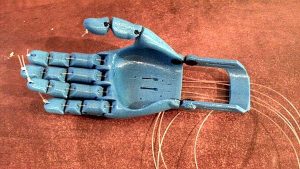
“3D printed Hand” by Intel FreePress is licensed under CC BY-SA 2.0

“CSIRO ScienceImage 2061 Hands holding a 3D printed mouthpieceprinted from titanium.jpg” by CSIRO is licensed under CC BY 3.0
Robotic Assisted Surgery
Key Takeaways
Robotic-assisted surgery is becoming more advanced as technology advances and is used to help surgeons be precise, accurate, and help have less damage done to the surrounding tissue.
Robotic-assisted surgery started around the 1980s but didn’t become very popular until 2012 when there was an increase in Robotic-assisted surgery by 13%. With technology advancing “the surgical robotic market is growing” throughout time which will allow for better machines, (Diana, M., & Marescaux, J). Robotic-assisted surgery will help the surgeons stabilize their arm, give better visualization, and allow for increased accuracy. Before robotic-assisted surgery, more common techniques were laparoscopic surgery or arthroscopic surgery. The robot used for the surgery costs upwards of 2 million dollars, but due to its popularity, it’s quickly paid off by the patients. For Robotic-assisted surgery the surgeon uses controls from the outside to manipulate tools to have the robot replicate the movements given. The only downfall of the surgery is time since it is such a complex machine it takes longer than a traditional surgery to complete.
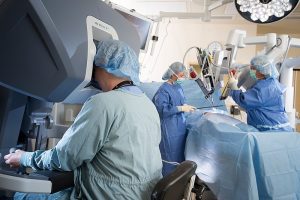
“Robot assisted surgery” by فاطمه درستی is licensed under CC BY-SA 4.0
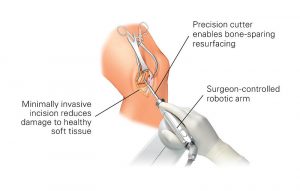
“MAKOplasty Partial Knee drwing w labels” by MAKO Surgical Corp is licensed under CC BY-SA 3.0
Arthroscopic Surgery
Key Takeaways
Arthroscopic surgery is a branch off of robotic surgery in the sense that it utilizes the use of technology and fiber optics to view the damaged joints or tendons.
Most commonly used for joints, Arthroscopic (ar·thros·co·pic) surgery is when two small incisions are made near the area that the surgeon is working on normally smaller than an inch. The surgeon then uses one incision to place the instrument or tool into the damaged area and the other incision to place a camera or scope inside to view the inside of the area on a bigger screen. With this surgery, surgeons hope for a faster recovery and less pain after the procedure. The advantage of Arthroscopic surgery is that the surgeon doesn’t have to open the joint completely to be able to complete the reconstruction since “traditional replacement surgery of this area has not been as effective as typically seen in the usual knee joint” (Health & Beauty Close-Up.). The first Arthroscopic surgery was started in Tokyo in 1919. The surgeon used a 7.3 mm scope to view inside the knee joint. This surgery benefited a lot from the advancements of technology specially looking into the fiber optics. This allows the surgeon to have a clear image of what they are looking at inside the joint.
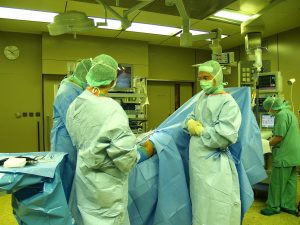
“Hospital Operation Meniscus Free Photo” by HansMartinPaul is in the Public Domain
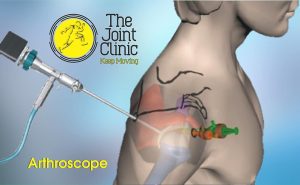
“Shoulder Arthroscopy” by The Joint Clinic is licensed under CC BY-SA 4.0
Laparoscopic Surgery
Key Takeaways
Laparoscopic is still advancing along with technology but its usage now is creating easy procedures specifically for cardiac surgeons.
Laparoscopic (lap·a·ros·co·py) Surgery is used specially for the pelvis and the abdomen but has recently advanced into the intestines. The instrument used by the surgeon is a trochar, which is a narrow tube which the tool is inserted into. Previously this type of surgery was known as a gynecologic surgery or gall bladder surgery. Laparoscopic surgery has been around for a little bit but is no longer popular for general surgeons. Instead of getting rid of the surgery entirely, Gastroenterologists and Gynecologist show value within. It took awhile for Laparoscopic surgery to be where it is today. This is due to the limitations on technology. Since it was such a new technique the general public felt very skeptical about the procedure. As technology began to advance more Laparoscopic surgery added its first robotic system in 1994 which allowed “the surgeon is able to use three instruments simultaneously” (Snehlata Shrivastav). With the use of the Robotic system it allows surgeons to complete complex tasks that would surpass the traditional Laparoscopic surgery.
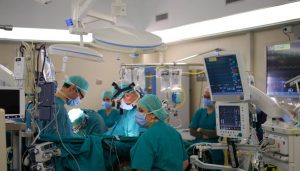
“Cardiac surgery operating room.jpg” by Pfree2014 is licensed under CC BY-SA 4.0

Examples
- 1.1: Briefly goes over each topic that will be discussed in the chapter
- 1.2: Covers medical 3-d printing and its advancements in dental impacts and prosthetics
- 1.3: Talks about Robotic Assisted Surgery in the medical field and how the produce is completed
- 1.4: Examples of certain Arthroscopic surgeries and how it has advanced
- 1.5: Laparoscopic surgeries advancements with new fields and how technology will allow for more opportunities in the future
Review Questions:
- True or False Question: Laparoscopic surgery is used for joints and ligaments, most commonly used with ACL surgery.
- True
- False
- What does the term ‘slicing’ mean?
-
- The 3-D printed implant is created layer by layer
- To cut something open
- The 3-D printed implant is created from a solid piece and craved away from
- A way of measuring for a prosthetic
-
- Who is Charles Hull?
-
-
- He invented the robot to assist in surgeries
- A surgeon
- A patient who 3-D printed their own prosthetic
- He started medical 3-D printing
-
-
- How has Robotic-assisted surgeries helped with ACL reconstruction?
Answers
- False – The correct answer is: Arthroscopic
- A – The correct answer is: The 3-D printed implant is created layer by layer
- D – The correct answer is: He started medical 3-D printing
References
Diana, M., & Marescaux, J. (2015). Robotic surgery. British Journal of Surgery, 102(2), e15–e28. https://doi.org/10.1002/bjs.9711
https://bjssjournals-onlinelibrary-wiley-com.libproxy.clemson.edu/doi/abs/10.1002/bjs.9711
Kimeldorf, D. (1953). Alterations in organ and body growth of rats following daily exhaustive exercise,
irradiation, and post-irradiation exercise / D.J. Kimeldorf, S.J. Baum. U.S. Naval Radiological
Defense Laboratory, 1953. https://babel.hathitrust.org/cgi/pt?id=mdp.39015095071224&view=1up&seq=5
Li, H., Fan, W., & Zhu, X. (2020). Three‐dimensional printing: The potential technology widely used
in medical fields. Journal of Biomedical Materials Research. Part A, 108(11), 2217–2229. https://doi.org/10.1002/jbm.a.36979
McMullen, D., Hotson, G., Katyal, K., Wester, B., Fifer, M., McGee, T., Harris, A., Johannes, M.,Vogelstein, R., Ravitz, A., Anderson, W., Thakor, N., & Crone, N. (2014). Demonstration of a Semi-Autonomous Hybrid Brain–Machine Interface Using Human Intracranial EEG, Eye Tracking, and Computer Vision to Control a Robotic Upper Limb Prosthetic. IEEE Transactions on Neural Systems and Rehabilitation Engineering, 22(4), 784–796. https://doi.org/10.1109/tnsre.2013.2294685 https://ieeexplore-ieee-org.libproxy.clemson.edu/document/6683036
Ryan White CARE Act Amendments of 2000 : report (to accompany S. 2311). (2000). U.S. G.P.O., 2000. https://babel.hathitrust.org/cgi/pt?id=pur1.32754071812626&view=1up&seq=2
San Francisco Doctor Performs Robot-Assisted Knee Replacement Surgery. (2011). Health & Beauty
Close-Up. https://bi-gale-com.libproxy.clemson.edu/essentials/article/GALE%7CA253889978?u=clemson
u_main
Snehlata Shrivastav. (2017, January 27). City gets its first robotic laparoscopic surgery unit. The Times of India (Bombay, India). https://bi-gale-com.libproxy.clemson.edu/essentials/article/GALE%7CA479017784?u=clemson
u_main
